Related Research Articles

The National Advisory Committee for Aeronautics (NACA) was a United States federal agency founded on March 3, 1915, to undertake, promote, and institutionalize aeronautical research. On October 1, 1958, the agency was dissolved and its assets and personnel were transferred to the newly created National Aeronautics and Space Administration (NASA). NACA is an initialism, i.e., pronounced as individual letters, rather than as a whole word.
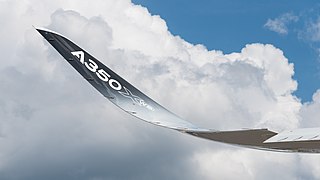
Wingtip devices are intended to improve the efficiency of fixed-wing aircraft by reducing drag. Although there are several types of wing tip devices which function in different manners, their intended effect is always to reduce an aircraft's drag. Wingtip devices can also improve aircraft handling characteristics and enhance safety for following aircraft. Such devices increase the effective aspect ratio of a wing without greatly increasing the wingspan. Extending the span would lower lift-induced drag, but would increase parasitic drag and would require boosting the strength and weight of the wing. At some point, there is no net benefit from further increased span. There may also be operational considerations that limit the allowable wingspan.
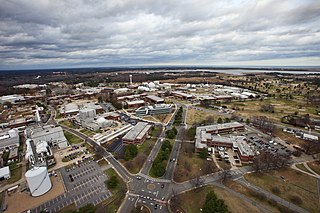
The Langley Research Center, located in Hampton, Virginia near the Chesapeake Bay front of Langley Air Force Base, is the oldest of NASA's field centers. LaRC has focused primarily on aeronautical research but has also tested space hardware such as the Apollo Lunar Module. In addition, many of the earliest high-profile space missions were planned and designed on-site. Langley was also considered a potential site for NASA's Manned Spacecraft Center prior to the eventual selection of Houston, Texas.

The NASA X-43 was an experimental unmanned hypersonic aircraft with multiple planned scale variations meant to test various aspects of hypersonic flight. It was part of the X-plane series and specifically of NASA's Hyper-X program. It set several airspeed records for jet aircraft. The X-43 is the fastest jet-powered aircraft on record at approximately Mach 9.6.

The Air Force Research Laboratory (AFRL) is a scientific research and development detachment of the United States Air Force Materiel Command dedicated to leading the discovery, development, and integration of direct-energy based aerospace warfighting technologies, planning and executing the Air Force science and technology program, and providing warfighting capabilities to United States air, space, and cyberspace forces. It controls the entire Air Force science and technology research budget which was $2.4 billion in 2006.
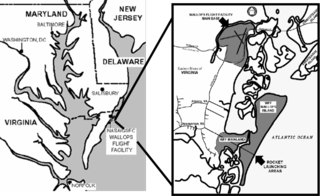
Wallops Flight Facility (WFF) is a rocket launch site on Wallops Island on the Eastern Shore of Virginia, United States, just east of the Delmarva Peninsula and approximately 100 miles (160 km) north-northeast of Norfolk. The facility is operated by the Goddard Space Flight Center in Greenbelt, Maryland, and primarily serves to support science and exploration missions for NASA and other Federal agencies. WFF includes an extensively instrumented range to support launches of more than a dozen types of sounding rockets; small expendable suborbital and orbital rockets; high-altitude balloon flights carrying scientific instruments for atmospheric and astronomical research; and, using its Research Airport, flight tests of aeronautical research aircraft, including unmanned aerial vehicles.
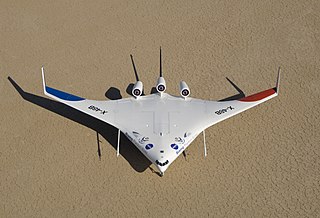
The Boeing X-48 is an American experimental unmanned aerial vehicle (UAV) built to investigate the characteristics of blended wing body (BWB) aircraft. Boeing designed the X-48 and two examples were built by Cranfield Aerospace in the UK. Boeing began flight testing the X-48B version for NASA in 2007. The X-48B was later modified into the X-48C version, which was flight tested from August 2012 to April 2013. Boeing and NASA plan to develop a larger BWB demonstrator.

Dream Chaser is an American reusable lifting-body spaceplane being developed by Sierra Space. Originally intended as a crewed vehicle, the Dream Chaser Space System is set to be produced after the cargo variant, Dream Chaser Cargo System, is operational. The crewed variant is planned to carry up to seven people and cargo to and from low Earth orbit.
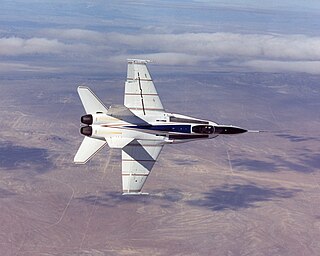
The X-53 Active Aeroelastic Wing (AAW) development program is a completed American research project that was undertaken jointly by the Air Force Research Laboratory (AFRL), Boeing Phantom Works and NASA's Dryden Flight Research Center, where the technology was flight tested on a modified McDonnell Douglas F/A-18 Hornet. Active Aeroelastic Wing Technology is a technology that integrates wing aerodynamics, controls, and structure to harness and control wing aeroelastic twist at high speeds and dynamic pressures. By using multiple leading and trailing edge controls like "aerodynamic tabs", subtle amounts of aeroelastic twist can be controlled to provide large amounts of wing control power, while minimizing maneuver air loads at high wing strain conditions or aerodynamic drag at low wing strain conditions. This program was the first full-scale proof of AAW technology.

The Environmental Research Aircraft and Sensor Technology, or ERAST program was a NASA program to develop cost-effective, slow-flying unmanned aerial vehicles (UAVs) that can perform long-duration science missions at altitudes above 60,000 ft (18,000 m). The project included a number of technology development programs conducted by the joint NASA-industry ERAST Alliance. The project was formally terminated in 2003.

The NASA Office of Inspector General is the inspector general office in the National Aeronautics and Space Administration, the space agency of the United States. The OIG's stated mission is to "prevent and detect crime, fraud, waste, abuse, and mismanagement and promote efficiency, effectiveness, and economy throughout NASA."

The National Aeronautics and Space Administration is an independent agency of the U.S. federal government responsible for the civil space program, aeronautics research, and space research. Established in 1958, NASA succeeding the National Advisory Committee for Aeronautics (NACA), to give the U.S. space development effort a distinctly civilian orientation, emphasizing peaceful applications in space science. NASA has since led most American space exploration, including Project Mercury, Project Gemini, the 1968–1972 Apollo Moon landing missions, the Skylab space station, and the Space Shuttle. NASA currently supports the International Space Station and oversees the development of the Orion spacecraft and the Space Launch System for the crewed lunar Artemis program, the Commercial Crew spacecraft, and the planned Lunar Gateway space station.

Aurora Flight Sciences is an American aviation and aeronautics research subsidiary of Boeing which primarily specializes in the design and construction of special-purpose Unmanned aerial vehicles. Aurora has been established for 20+ years and their headquarters is at the Manassas Regional Airport in Manassas, Virginia.

Development of the Commercial Crew Program began in the second round of the Commercial Crew Development (CCDev) program, which was rescoped from a technology development program for human spaceflight to a competitive development program that would produce the spacecraft to be used in the Commercial Crew Program to provide crew transportation services to and from the International Space Station (ISS). To implement the program NASA awarded a series of competitive fixed-price contracts to private vendors starting in 2011. Operational contracts to fly astronauts were awarded in September 2014 to SpaceX and Boeing, and NASA expected each company to complete development and achieve crew rating in 2017. Each company performed an uncrewed orbital test flight in 2019. SpaceX operational flights started in November 2020.
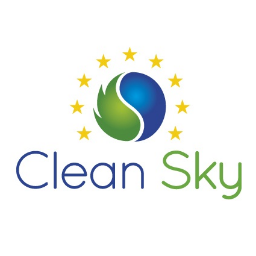
The Clean Sky Joint Undertaking (CSJU) is a public-private partnership between the European Commission and the European aeronautics industry that coordinates and funds research activities to deliver significantly quieter and more environmentally friendly aircraft. The CSJU manages the Clean Sky Programme (CS) and the Clean Sky 2 Programme (CS2), making it Europe's foremost aeronautical research body.
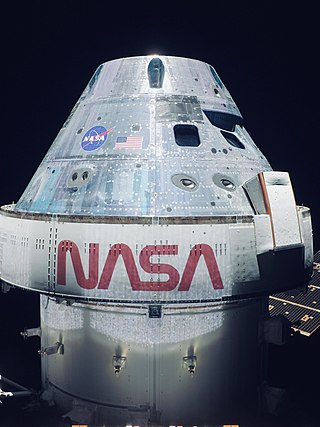
Orion is a partially reusable crewed spacecraft used in NASA's Artemis program. The spacecraft consists of a Crew Module (CM) space capsule designed by Lockheed Martin and the European Service Module (ESM) manufactured by Airbus Defence and Space. Capable of supporting a crew of six beyond low Earth orbit, Orion can last up to 21 days undocked and up to six months docked. It is equipped with solar panels, an automated docking system, and glass cockpit interfaces modeled after those used in the Boeing 787 Dreamliner. A single AJ10 engine provides the spacecraft's primary propulsion, while eight R-4D-11 engines, and six pods of custom reaction control system engines developed by Airbus, provide the spacecraft's secondary propulsion. Although compatible with other launch vehicles, Orion is primarily intended to launch atop a Space Launch System (SLS) rocket, with a tower launch escape system.

Since its establishment in 1958, NASA has conducted research on a range of topics. Because of its unique structure, work happens at various field centers and different research areas are concentrated in those centers. Depending on the technology, hardware and expertise needed, research may be conducted across a range of centers.
The ecoDemonstrator Program is a Boeing flight test research program, which has used a series of specially modified aircraft to develop and test aviation technologies designed to improve fuel economy and reduce the noise and ecological footprint of airliners.

The NASA X-57 Maxwell was an experimental aircraft being developed by NASA, intended to demonstrate technology to reduce fuel use, emissions, and noise. The first flight of the X-57 was scheduled to take place in 2023, but the program was cancelled due to problems with the propulsion system.

SNC Demo-1, also known as Dream Chaser Demo-1, is the planned first flight of the Sierra Nevada robotic resupply spacecraft Dream Chaser to the International Space Station (ISS) under the CRS-2 contract with NASA. The demonstration mission is planned for launch in early 2024 on the second flight of the ULA Vulcan Centaur rocket. Sierra Nevada Corporation (SNC) developed a new reusable spacecraft to provide commercial cargo resupply services to the International Space Station (ISS), based on decades of lifting body programs. Under the Commercial Orbital Transportation System (COTS) program, SNC designed Dream Chaser with industrial partner Lockheed Martin. SNC also designed the accompanying Shooting Star cargo module with subcontractor Applied Composites. At the end of mission, the Shooting Star will destructively reenter the atmosphere and the Dream Chaser will land at the Kennedy Space Center's Shuttle Landing Facility.
References
- ↑ Foust, Jeff (September 22, 2021). "NASA splits human spaceflight directorate into two organizations". Space News. Retrieved September 11, 2022.
- ↑ "NASA Administrator Names Robert Pearce Head of Agency Aeronautics". NASA. December 10, 2019. Retrieved September 6, 2022– via prnewswire.
- 1 2 "About Us". Nasa.gov. NASA. Archived from the original on 12 May 2013. Retrieved 17 June 2016.
- ↑ NASA Office of Inspector General (January 30, 2014). "NASA OIG: The Aeronautics Research Mission Directorate's Management Strategy for Conducting Aeronautics Research". Spaceref.com. Retrieved 23 June 2016.[ permanent dead link ]
- 1 2 Committee to Assess NASA’s Aeronautics Flight Research Capabilities (2012). "Chapter 1: NASA's Aeronautics Research Mission Directorate—Why Flight Research?". Recapturing NASA's Aeronautics Flight Research Capabilities. National Research Council. ISBN 978-0-309-25538-7 . Retrieved 23 June 2016.
- 1 2 Graham Warwick (Feb 19, 2018). "The Week In Technology, February 19-23, 2018". Aviation Week & Space Technology.
- ↑ "Aeronautics Research Mission Directorate Programs". Nasa.gov. NASA. Archived from the original on 29 October 2005. Retrieved 23 June 2016.
- ↑ Guy Norris (Feb 4, 2019). "NASA's Advanced Composite Wing Tests Aim At Airliner Future Efficiency". Aviation Week & Space Technology.